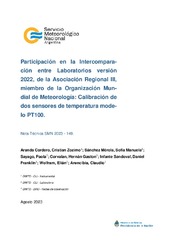Participación en la Intercomparación entre Laboratorios versión 2022, de la Asociación Regional III, miembro de la Organización Mundial de Meteorología: Calibración de dos sensores de temperatura modelo PT100
Autores

Resumen
En esta nota técnica se detalla el proyecto llamado Intercomparación entre Laboratorios o Interlaboratory Comparison
(ILC) que sirve como una herramienta para la comparación de resultados llevados a cabo por laboratorios
donde se realizan calibraciones de instrumentos para la meteorología, los cuales pueden estar acreditados o no
acreditados en el campo de medición correspondiente. Esta versión de la ILC se realizó en la asociación regional
III, miembro de la WMO, cuya organización fue llevada a cabo por el SMN, que alberga al Centro Regional de
Instrumentos de Buenos Aires (RIC III) y el INTI; con el apoyo de la asociación regional VI, miembro de la WMO
conformado por la Agencia Ambiental de Eslovenia (RIC VI), la Facultad de Ingeniería Eléctrica de la Universidad de
Liubliana, el Laboratorio de Metrología y Calidad y el Instituto Nacional de Metrología Italiano (INRIM). La importancia
de participar en este tipo de proyectos consiste en mejorar los procesos de medición, encontrar las deficiencias
técnicas de los instrumentos utilizados y mejorar la técnica de la medición de incertidumbre. La experiencia consistió
en realizar el proceso de calibración para la magnitud temperatura. Dicho procedimiento se realizó en cuatro
etapas. En base al instrumental recibido, la primer etapa consistió en el armado y montaje del banco de medición,
tal que este permita medir las variables. En la segunda etapa se analizaron, filtraron y prepararon las mediciones
obtenidas. En una tercera etapa se realizó el proceso de calibración y en la cuarta y última etapa, se realizó el
análisis de los resultados. Dichos resultados serán evaluados según un método de aceptación determinado por los
laboratorios organizadores. Así, para cada punto medido se obtuvo un valor promedio de la medición junto a su incertidumbre
expandida asociada. Para mejorar el proceso de calibración en la variable temperatura se recomienda
utilizar sensores con un tiempo de respuesta más corto, acorde a las variaciones del ambiente. La participación del
laboratorio del SMN en este proyecto es uno de los primeros pasos para la acreditación de la ISO/IEC 17025:2017.
This technical note details the project called Interlaboratory Comparison or Interlaboratory Comparison (ILC) that
serves as a tool for comparing results carried out by laboratories where calibrations of meteorological instruments
are performed, which can be accredited or not accredited in the corresponding field of measurement. This version
of the ILC was carried out in the regional association III, a member of the WMO, whose organization was carried
out by the SMN, which houses the Regional Instrument Center of Buenos Aires (RIC III) and the INTI; with the
support of the regional association VI, a member of the WMO made up of the Slovenian Environmental Agency
(RIC VI), the Faculty of Electrical Engineering of the University of Ljubljana, the Laboratory of Metrology and Quality
and the Italian National Institute of Metrology. The importance of participating in this type of project consists in
improving the measurement processes, finding the technical deficiencies of the instruments used and improving
the uncertainty measurement technique. The experience consisted of carrying out the calibration process for the
magnitude temperature. This procedure was carried out in four stages. Based on the instruments received, the first
stage consisted of the building and assembling of the measurement bench, such that it allows the variables to be
measured. In the second stage, the measurements obtained were analyzed, filtered and prepared. In a third stage,
the calibration process was carried out and in the fourth and last stage, the analysis of the results was executed.
These results will be evaluated according to an acceptance method determined by the organizing laboratories. Thus,
for each measured point, an average value of the measurement was obtained together with its associated expanded
uncertainty. The results obtained showed that the pressure variable presents a similar uncertainty between the
different measured points, this is due to the fact that the measurement bank quickly reaches stabilization, that is,
it presents very small oscillations around each point. To improve the calibration process in the temperature and humidity variables, it is recommended to use sensors with a shorter response time, according to the variations of
the environment. The participation of the SMN laboratory in this project is one of the first steps towards ISO/IEC
17025:2017 accreditation.
Cita
Colecciones
- Notas técnicas [207]
Fecha
2023-09Metadatos
Mostrar el registro completo del ítemUtilice este identificador (URI) para citar o enlazar este item
http://hdl.handle.net/20.500.12160/2563El ítem tiene asociados los siguientes ficheros de licencia: